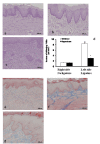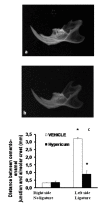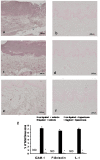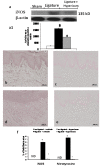Effects of Hypericum Perforatum, in a rodent model of periodontitis - PubMed (original) (raw)
Effects of Hypericum Perforatum, in a rodent model of periodontitis
Irene Paterniti et al. BMC Complement Altern Med. 2010.
Abstract
Background: Hypericum perforatum is a medicinal plant species containing many polyphenolic compounds, namely flavonoids and phenolic acids. In this study we evaluate the effect of Hypericum perforatum in animal model of periodontitis.
Methods: Periodontitis was induced in adult male Sprague-Dawley rats by placing a nylon thread ligature around the lower 1st molars. Hypericum perforatum was administered at the dose of 2 mg/kg os, daily for eight days. At day 8, the gingivomucosal tissue encircling the mandibular first molar was removed.
Results: Periodontitis in rats resulted in an inflammatory process characterized by edema, neutrophil infiltration and cytokine production that was followed by the recruitment of other inflammatory cells, production of a range of inflammatory mediators such as NF-κB and iNOS expression, the nitration of tyrosine residues and activation of the nuclear enzyme poly (ADP-ribose) polymerase; apoptosis and the degree of gingivomucosal tissues injury. We report here that Hypericum perforatum exerts potent anti-inflammatory effects significantly reducing all of the parameters of inflammation as described above.
Conclusions: Taken together, our results clearly demonstrate that treatment with Hypericum reduces the development of inflammation and tissue injury, events associated with periodontitis.
Figures
Figure 1
Inflammatory cells infiltration and edema were observed in gingivomucosal section from ligature-treated rats (b) when compared with gingivomucosal tissue section taken from controlateral side (a). Significantly less edema and inflammatory cell infiltration was observed in gingivomucosal sections from ligature-treated rats which had been treated with Hypericum (c). The total number of infiltrating leukocytes (e.g., neutrophil and mononuclear cells) in gingivomucosal tissue was assessed quantitatively by counting the number of polymorphonuclear cell in 20 high-power fields (d). Moreover Masson's trichrome stain was negative in gingivomucosal tissue sections taken from the contralateral side from vehicle when compared with gingivomucosal tissues sections of ligature-operated rats (e, f.). Hypericum treatment reduced the increase of collagen (Fig g) Figures are representative of at least 3 experiments performed on different experimental days. The tissue sections, orientated longitudinally from the teeth crown, were stained with trichrome stain. Data represent the mean ± S.E.M. for 20 counts obtained from the gingivomucosal tissue of each treatment group. * < P0.01 vs. non-ligated; °P < 0.01 vs. ligated.
Figure 2
The alveolar bone from ligated (8 days) rats demonstrated alveolar bone resorption (a). Hypericum treatment suppressed alveolar pathology in the rat alveolar bone (b). A significant increase in the distance between cemento-enamel injunction and alveolar crest at mediolingulal root of the first molar was observed in ligature-treated rats (c). Hypericum treatment significantly reduced the increase in the distance between cemento-enamel injunction and alveolar crest (c). Radiographic figure is representative of at least 3 experiments performed on different experimental days. Data represent the data from 20 counts obtained from the gingivomucosal tissue of each treatment group. *P < 0.01 vs. non-ligated; °P < 0.01 vs. ligated.
Figure 3
We evaluated IκB-α degradation and nuclear NF-κB p65 by Western Blot analysis. A basal level of IκB-α was detected in the gingivomucosal tissue sections taken from the contralateral side (a, a1). IκB-α levels were substantially reduced (a, a1.) in the gingivomucosal tissues from ligature operated rats. Hypericum treatment prevented IκB-α degradation, (3a, a1). Periodontitis caused a significant increase in the NF-kB p65 levels in the gingivomucosal tissues from operated rats (b, b1). Hypericum treatment significantly prevented the periodontitis-mediated NF-kB p65 expression (b, b1).
Figure 4
Evans blue content (b) and Myeloperoxidase activity (a) in gingivomucosal tissue was significantly increased by ligature compared to the contralateral side. Hypericum significantly reduced myeloperoxidase activity levels and Evans blue content (a, b respectively). Densitometry data are expressed as % of total tissue area. Data are means of mean ± s.e.m. from N = 10 rats for each group. *P < 0.01 vs. non-ligated. ° < b0.01 vs. ligated.
Figure 5
Positive staining for IL-1β (a, see densitometry analysis g) was observed in gingivomucosal tissue after ligature mainly localized in the epidermis and in inflammatory cells in derma In gingivomucosal tissue of Hypericum-treated rats no positive staining was observed for IL-1β (b, see densitometry analysis g). Moreover 8 days following ligation, positive staining for ICAM-1 and P-selectin, were found in the gingivomucosal tissues from ligature operated rats (c and e respectively, see densitometry analysis g). In contrast, a positive staining for ICAM-1 and P-selectin was significantly attenuated by the treatment with Hypericum (d and f respectively, see densitometry analysis g). Figure is representative of at least 3 experiments performed on different experimental days. Densitometry data are expressed as % of total tissue area. Data are means of mean ± s.e.m. from N = 10 rats for each group. *P < 0.01 vs. non-ligated. ° < b0.01 vs. ligated.
Figure 6
A significant increase in iNOS expression, assayed by Western blot analysis, was detected in the tissue from ligature-treated rats (a, a1). The treatment with Hypericum significantly reduced iNOS expression in the gingivomucosal tissues (a, a1). Moreover positive staining for iNOS (b see densitometry analysis f), and nitrotyrosine (d see densitometry analysis f) was observed in gingivomucosal tissue after ligature. In gingivomucosal tissue of Hypericum treated rats no positive staining was observed for iNOS (c see densitometry analysis f), nitrotyrosine (e, see densitometry analysis f). Figure is representative of at least 3 experiments performed on different experimental days. Densitometry data are expressed as % of total tissue area. Data are means of mean ± s.e.m. from N = 10 rats for each group. *P < 0.01 vs. non-ligated. ° < b0.01 vs. ligated.
Figure 7
Western blot analysis was performed on gingivomucosal tissue collected 8 days after injury. Basal level of Bax was present in the tissue from-sham operated rats (a, a1). Bax band is more evident in the tissue from ligature treated rats (a, a1). The Bax band disappeared in the tissue from ligated rats that received Hypericum (a, a1). Moreover a basal level of Bcl-2 was present in the tissue from sham-operated rats (b, b1). The Bcl-2 band disappeared in the tissue from rats subjected to ligation (b, b1). The Bcl-2 band is more evident in the tissue from ligated rats that received Hypericum (b, b1). The immunoblot in (a and b) represents one tissue of the 5-6 analyzed. The results in (a1 and b1) are expressed as mean 7 s.e.m. from 5-6 tissues. *P < 0.01 vs non-ligated; °P < 0.01 vs ligated.
Similar articles
- Effects of verbascoside, biotechnologically purified by Syringa vulgaris plant cell cultures, in a rodent model of periodontitis.
Paola RD, Oteri G, Mazzon E, Crisafulli C, Galuppo M, Toso RD, Pressi G, Cordasco G, Cuzzocrea S. Paola RD, et al. J Pharm Pharmacol. 2011 May;63(5):707-17. doi: 10.1111/j.2042-7158.2011.01262.x. Epub 2011 Apr 1. J Pharm Pharmacol. 2011. PMID: 21492173 - Hypericum perforatum attenuates the development of cerulein-induced acute pancreatitis in mice.
Genovese T, Mazzon E, Di Paola R, Muià C, Crisafulli C, Menegazzi M, Malleo G, Suzuki H, Cuzzocrea S. Genovese T, et al. Shock. 2006 Feb;25(2):161-7. doi: 10.1097/01.shk.0000188326.82641.b7. Shock. 2006. PMID: 16525355 - Effects of Hypericum perforatum extract in a rat model of ischemia and reperfusion injury.
De Paola R, Muià C, Mazzon E, Genovese T, Crisafulli C, Menegazzi M, Caputi AP, Suzuki H, Cuzzocrea S. De Paola R, et al. Shock. 2005 Sep;24(3):255-63. doi: 10.1097/01.shk.0000175428.57769.34. Shock. 2005. PMID: 16135965 - Do other Hypericum species have medical potential as St. John's wort (Hypericum perforatum)?
Stojanović G, Ðorđević A, Šmelcerović A. Stojanović G, et al. Curr Med Chem. 2013;20(18):2273-95. doi: 10.2174/0929867311320180001. Curr Med Chem. 2013. PMID: 23521674 Review. - Evidence for contributions of interactions of constituents to the anti-inflammatory activity of Hypericum perforatum.
Hammer KD, Birt DF. Hammer KD, et al. Crit Rev Food Sci Nutr. 2014;54(6):781-9. doi: 10.1080/10408398.2011.607519. Crit Rev Food Sci Nutr. 2014. PMID: 24345048 Review.
Cited by
- Biological Effects of Medicinal Plants on Induced Periodontitis: A Systematic Review.
de Oliveira JS, Pinto ME, Santana LA, Pinto AS, di Lenardo D, Vasconcelos DF. de Oliveira JS, et al. Int J Dent. 2016;2016:3719879. doi: 10.1155/2016/3719879. Epub 2016 Sep 21. Int J Dent. 2016. PMID: 27738432 Free PMC article. Review. - Anti-inflammatory and Anti-oxidant Activity of Hidrox® in Rotenone-Induced Parkinson's Disease in Mice.
Siracusa R, Scuto M, Fusco R, Trovato A, Ontario ML, Crea R, Di Paola R, Cuzzocrea S, Calabrese V. Siracusa R, et al. Antioxidants (Basel). 2020 Sep 3;9(9):824. doi: 10.3390/antiox9090824. Antioxidants (Basel). 2020. PMID: 32899274 Free PMC article. - The Promising Role of Antioxidant Phytochemicals in the Prevention and Treatment of Periodontal Disease via the Inhibition of Oxidative Stress Pathways: Updated Insights.
Vo TTT, Chu PM, Tuan VP, Te JS, Lee IT. Vo TTT, et al. Antioxidants (Basel). 2020 Dec 1;9(12):1211. doi: 10.3390/antiox9121211. Antioxidants (Basel). 2020. PMID: 33271934 Free PMC article. Review. - The immuno-regulatory impact of orally-administered Hypericum perforatum extract on Balb/C mice inoculated with H1n1 influenza A virus.
Huang N, Singh N, Yoon K, Loiacono CM, Kohut ML, Birt DF. Huang N, et al. PLoS One. 2013 Sep 30;8(9):e76491. doi: 10.1371/journal.pone.0076491. eCollection 2013. PLoS One. 2013. PMID: 24098792 Free PMC article. - A systematic review for anti-inflammatory property of clusiaceae family: a preclinical approach.
de Melo MS, Quintans Jde S, Araújo AA, Duarte MC, Bonjardim LR, Nogueira PC, Moraes VR, de Araújo-Júnior JX, Ribeiro EA, Quintans-Júnior LJ. de Melo MS, et al. Evid Based Complement Alternat Med. 2014;2014:960258. doi: 10.1155/2014/960258. Epub 2014 May 26. Evid Based Complement Alternat Med. 2014. PMID: 24976853 Free PMC article. Review.
References
- Page RC, Schroeder HE. Pathogenesis of inflammatory periodontal disease. A summary of current work. Lab Invest. 1976;34:235–249. - PubMed
MeSH terms
Substances
LinkOut - more resources
Full Text Sources
Medical






